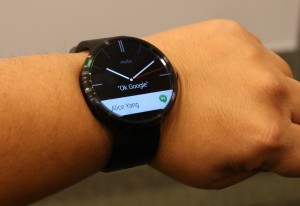
Like you all, we’ve been digesting the wearables news that came out of Google I/O last week, and puzzling a bit over its paucity. There was very little about Glass, which may or may not indicate that it’s no longer a development project but may be about to be a project. (Remember, I/O is a developers’ conference.) And we were kind of surprised about the muted reception for Android Wear.
It’s true that vendors showed several smartwatches that are due later this year, and the popular thinking seems to be that only the Moto360 may be attractive enough for the general market. But a lot of the air went out of the market when Google announced that the Wear UI will be the Wear UI, with no tinkering allowed. This means the user experience will be the same for every Android Wear watch; the only difference will be the hardware.
Frankly, we’re of two minds about that. Consistency is a virtue; it’s one of the things that’s made Apple products so popular. Apple gets to control the user experience to a degree that’s easy to mock, except that people tend to like it. User experiences on Android phones are incredibly variable, which is not helped by carriers’ reluctance to push (or even allow) software upgrades to older phones. There is no “Android experience” on mobile phones, and that’s a mistake that Google is trying to avoid with Android Wear.
The Apple model works because there’s one manufacturer. The danger of taking that approach in a multivendor environment is that it risks commoditization, the way it has for Windows computers: if everything looks and works the same, then why pick one vendor over another?
The answer for watches may lie in the luxury market. Swatch makes the guts for some extraordinarily large percentage of the world’s watches, even at the high end. The difference is the case, the face, the strap, the aura. If that model holds for smartwatches, maybe we’ll find that big competitors aren’t tech companies like LG or Samsung, which will find their products in a race to the cheap end of the market. Maybe they’ll be Patek Philippe and Tissot, competing at the high end with the same software (perhaps better executed) but with really nice flashy hardware.